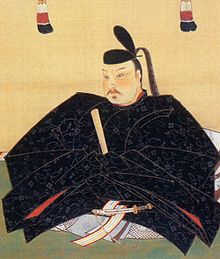Toyotomi Hidenaga
Toyotomi Hidenaga | |
|---|---|
 Toyotomi Hidenaga | |
| Native name | 豊臣 秀長 |
| Birth name | Koichirō (小一郎) |
| Other name(s) | Hashiba Koichirō (羽柴 小一郎) Hashiba Hidenaga (羽柴 秀長) |
| Born | April 8, 1540 |
| Died | February 15, 1591 (aged 50) Kōriyama, Yamato Province |
| Allegiance | |
| Rank | Dainagon |
| Unit | |
| Battles/wars | Battle of Yamazaki (1582) Invasion of Shikoku (1585) Kyūshū Campaign (1587) |
| Spouse(s) | Chiun'in |
| Relations | Chikuami (father) Ōmandokoro (mother) Toyotomi Hideyoshi (half-brother) Asahi no kata (sister) Toyotomi Hidetsugu (nephew) Toyotomi Hideyori (nephew) |
| Signature |  |
Toyotomi Hidenaga (豊臣 秀長, April 8, 1540 – February 15, 1591), formerly known as Hashiba Koichirō (羽柴 小一郎). He was a half-brother of Toyotomi Hideyoshi,[1] one of the most powerful and significant warlords of Japan's Sengoku period and regarded as 'Hideyoshi's brain and right-arm'.
He was also known by his court title, Dainagon (大納言). He promoted Tōdō Takatora to chief engineer. He led Hideyoshi's vanguard force a few years later into Satsuma Province, contributing heavily to his half-brother's victories in gaining control of Kyūshū. Hidenaga was awarded the provinces of Kii, Izumi and Yamato, reaching a governance of one million koku.
He took part in the 1582 Battle of Yamazaki, lead Toyotomi's troops at the Invasion of Shikoku (1585), and the 1587 Battle of Takajo, Battle of Sendaigawa and Siege of Kagoshima.[2]
He died in 1591, at Kōriyama, Yamato Province (now Nara Prefecture), and his tomb is called Dainagon-zuka (大納言塚).
Family[]
- Father: Chikuami
- Mother: Ōmandokoro (1516-1592)
- Siblings:
- Toyotomi Hideyoshi
- Asahi no kata
- Tomo, married
- Wife: Chiun'in
- Children:
- Koichiro later Yosuke
- Kikuhime, married Toyotomi Hideyasu
- Daizen-in, married Mori Hidemoto
Honours[]
- Junior Second Rank (August 8, 1587)
References[]
- ^ Sansom, George (1961). A History of Japan, 1334-1615. Satford University: Stanford University Press. p. 321. ISBN 0804705259.
- ^ Turnbull, Stephen (1998). The Samurai Sourcebook. London: Cassell & Co. pp. 236, 238, 240, 276. ISBN 9781854095237.
See also[]
- 1540 births
- 1591 deaths
- Samurai
- Japanese Buddhists
- Toyotomi clan
- Deified Japanese people
- Samurai stubs